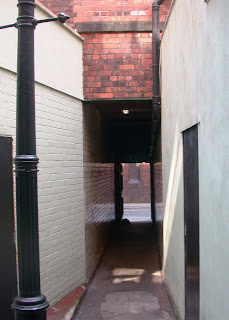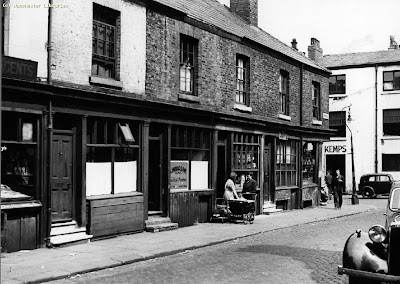I am on Camp Street just off Deansgate
 |
| Camps Street, 1938 |
And if I wanted to be more accurate we are standing in the Manchester and Salford Junction Canal Tunnel in 1938.
It is one of series of pictures which were taken by the City Engineers just under a hundred years after the canal opened to traffic in the October of 1839.
Forty years earlier the first proposals for a canal link from the river Irwell to the Rochdale Canal were floated in an effort to overcome the difficulties of off loading goods at the river and transporting them along the congested city streets.
The route of the canal across the city involved constructing a tunnel from Charles Street to Watson Street from which the waterway then ran in the open east as far as Lower Mosley Street before twisting south and running parallel with Chepstow Street before joining the Rochdale Canal just beyond Great Bridgewater Street.
 |
| Camp Street, 1947 showing what might be a shaft down to the canal |
Much of the street pattern and many of the industrial buildings from that period have long since gone and I guess most people are not even aware that there was this cross city canal.
I first came across it when researching Camp Street a few years back and then discovered more of its story in Underground Manchester.*
This is a fascinating book and feeds that interest many of us have in mysterious and long forgotten tunnels. Manchester has plenty of them and the book allows you to explore them through a collection of photographs, memories and documents.
It is a book I have long pondered on buying, but which in the end was passed onto me by David who often contributes to the blog. He was born here in Chorlton and has vivid memories of the place in the 1950s and 60s.
Now this fascination with our lost tunnels is an interesting one and stems I suppose from a mix of genuine historical curiosity and that preoccupation with the slightly mysterious.
After all most of them were built so long ago that in some cases there are no official plans of where they are and certainly no real idea of their original purpose.
Added to this they pop up as tantalizing half clues which might be a bricked up entrance in a city cellar, or a faded newspaper clipping of a chance discovery by workman at the beginning of the last century.
 |
| Camps Street 2012 |
In the case of our waterway it was a letter in the Manchester City News of 1882 which described seeing both the “the canal tunnel with a towing path [which] came out near the Black Horse Hotel, Alport, where now stands Central Station.”**
Now sometimes they border on the conspiratorial and many of us will be have been told the story from the friend of a friend who came across an underground communication centre built in the 1950s during the Cold War.
Most of which make perfect sense given the heightened conflict of the period.
But sometimes I have to say they just feed the imagination like the myth that a passageway runs under the green from the old parish church to the Horse & Jockey.
It is one of those fanciful ideas born of half remembered school history involving religious persecution, priest holes and a walloping big dose of wishful thinking.
We certainly did have our own martyr to the old religion but I doubt that the Barlow family would have constructed a tunnel across the green. And even had they done so I rather think it would have come to light during the last 400 years, either from one of the frequent burials that took place in the graveyard or the archaeological dig of the late 1970s and early 80s.
 |
| Camps Street, 1849 and the route of the canal in 1849 |
That said there is no doubt that many things lurk below our city streets which takes me back to Mr Warrender’s book and more particularly the Manchester and Salford Junction Canal Tunnel.
It was probably built as a cutting and then roofed over. Just at the entrance to the tunnel hard by Charles Street was a gasometer which supplied
“power of the lamps every thirty yards.”
Charles Street disappeared as the Liverpool Road warehouse complex expanded, along with Ashton Street, New Street and Dumbar Street and Garden Court.
But Camp Street is still there although the houses in this 1944 picture have long gone.
They were there during the construction of the canal which must have been irksome to the residents.
Not that I suspect either the owners of the land, or the houses or even the canal company were over bothered for the wishes of the occupants of the houses facing the work.
 |
| Camps Street, 1944 |
These were mostly families who earned a living from the work of skilled craftsmen, labourers and those engaged in work in the cotton mills.
Not I suspect that these people gave much thought to the men who were labouring in the tunnel just a few feet from their front doors which brings me back to that picture of the underground canal in 1938.
I have to say that there is something a little uncomfortable at about the picture which I suppose stems from my own dislike of enclosed places which are both dark and full of water.
But then by the time this picture was taken the canal had been closed to commercial traffic for two years and was on the way to becoming a forgotten place. Already the section from Watson Street to the Rochdale Canal had been closed for sixty three years and been backfilled in preparation for the construction of Central Station.
Location; Manchester
Pictures; C
amp Street canal, City Engineers, 1938, m77571, Camp Street, T. Braddeley, m00701, Camp Street, City Engineers, 1944, m78767, Camp Street, C.Holt, 1938, m00700, courtesy of Manchester Libraries, Information and Archives,
Manchester City Council, http://images.manchester.gov.uk/index.php?session=pass map of Camp Street showing underground route of the canal from the Manchester and Salford OS 1842-49, courtesy of Digital Archives, http://www.digitalarchives.co.uk/ and Camp Street, 2012 from the collection of Andrew Simpson
*Underground Manchester, Keith Warrender, Willow Press 2007, and also Below Manchester by the same author and publisher.
**ibid, Underground Manchester, page 23

















































